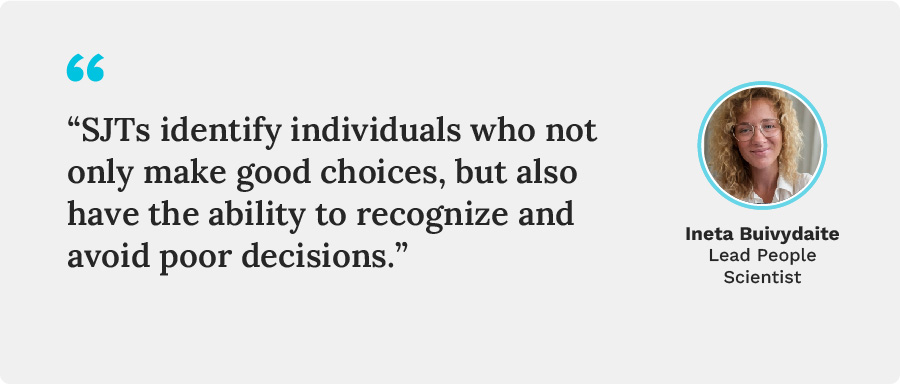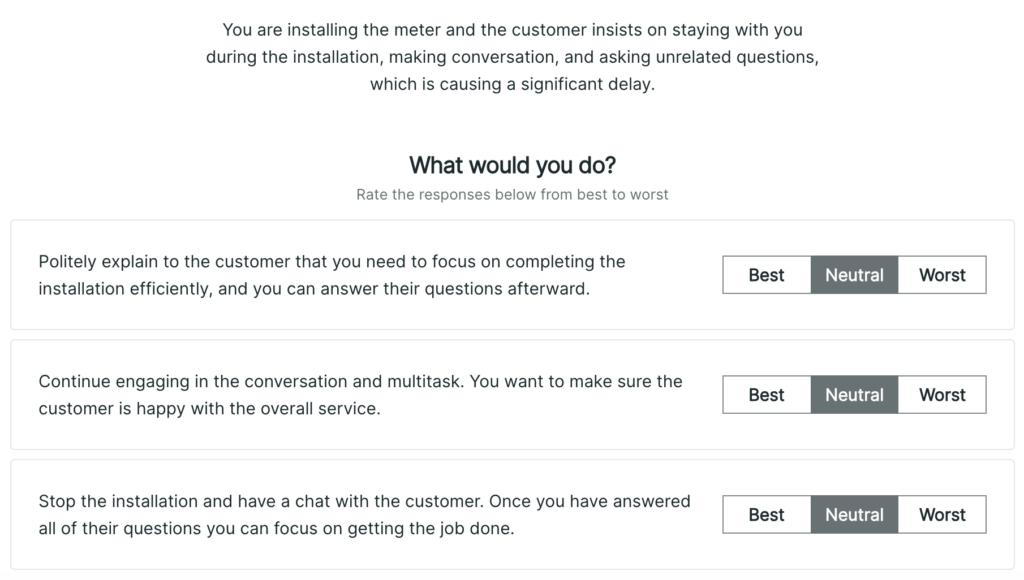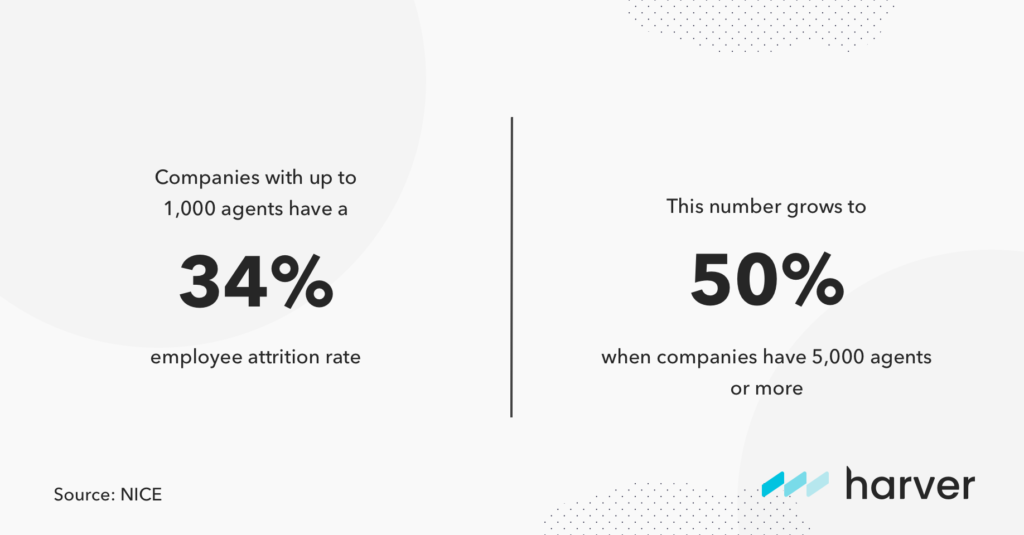A situational judgment test (sometimes spelled situational judgement test or shortened to SJT) is a common assessment method for job candidates. This type of situational assessment is used to assess a job seeker’s fit based on their reaction to common scenarios for the role.
For instance, maybe you’re hiring customer service representatives (CSRs) or retail associates. Do they have the interpersonal skills to handle an upset customer about a delayed shipment or out-of-stock item? An SJT can help your organization reliably predict success for the role at hand.
Keep reading to learn what a situational judgment test is and whether it makes sense to add this assessment method to your selection protocol.
What’s in?
What is a situational judgment test?
A situational judgment test (SJT) is a behavioral tool that provides realistic work scenarios related to a job’s day-to-day challenges and tasks. In these custom psychometric tests that have been used for personnel selection for more than a hundred years, candidates are asked what they would do in the situation. SJTs are popular because they provide a clear and reliable idea of how a candidate would react in the role.
When taking an SJT, candidates can select what they think is the best response to a scenario. For example, an SJT for a BPO role might ask which path is ideal when responding to a frustrated caller. This enables the recruiter to gauge if the candidate’s natural reaction and decision-making suit the ideal behavior for the job at hand.

Some SJTs, like Harver’s situational judgment tests, ask for both a best and worst response. Our I/O psychologists use this format to gather richer data for more informed decisions. “Requiring candidates to identify both the best and worst answers in an SJT is a way to provide a more comprehensive assessment of their decision-making and alignment to the role,” says Ineta Buivydaite, one of Harver’s Lead People Scientists. “It helps employers identify individuals who not only make good choices, but also have the ability to recognize and avoid poor decisions.”
Here’s an example of a Harver interactive video-based situational judgment item for E.ON, one of Europe’s largest operators of energy networks and energy infrastructure:

As you can see in the example above, SJTs can be targeted to specific tasks that involve hard and/or soft skills. And that’s not all, says Buivydaite. “With a video-based situational judgment test solution like Harver’s, organizations can also be very intentional about their employer branding.” For example, an employer can use Harver’s video SJTs to communicate their values, commitment to sustainability or DEI.
Situational judgment test formats
A situational judgment test may be given in various formats. In general, an SJT is presented as question and answer. A photo can also be included as part of the situational assessment, to give the candidate a more realistic preview of the job.
At Harver, we use interactive video-based SJTs. As John Ehlers, Creative Director at Harver, explains: “SJT videos provide more realistic work environment context for candidates, including the emotional elements of the job. Plus, they’re engaging for candidates.”
If you’re considering adding SJTs to your selection process for hourly roles, choose a provider that brings rigorous science and other value. “For example, with Harver you get videos for SJT items, plus custom content videos that engage the candidate and help push them through the assessment process. These videos together relay important company and specific job information to help set expectations for day 1,” says Ehlers. Altogether, these valuable videos help boost candidate satisfaction and highlight employer brand identity, while also supporting application completion rates by engaging candidates.
See for yourself. Here’s a quick compilation of some situational judgment test videos that Harver designed and produced for Valvoline Instant Oil Change, with over 1,700 locations.
Benefits of a situational judgment test
Situational judgment tests offer multiple benefits to employers. In general, the rationale behind implementing an SJT is that candidates who are better at the job will be more likely to label the best and worst course of action in a job-related situation.
According to Geoff Anthony, a Lead People Scientist at Harver, “Multidimensional SJTs are a good indicator of on-the-job performance because situational judgment tests measure a combination of skills and abilities that are highly related to the job.”
Here are the benefits to hiring organizations when including an SJT in their selection protocol:
SJT benefit: Faster ramp up to full performance
SJTs assess important aspects for the role. Using a retail associate role as an example, SJT items can be developed to focus on improving customer satisfaction. Anthony explains that “By providing a transparent and realistic idea of what the job is, new employees start day one with a better sense of what the position entails and may ramp up more quickly.”
SJT benefit: Reduced attrition for hourly roles
“Situational judgment tests are predictive for attrition, as well as for performance,” says Anthony. No wonder SJTs are especially popular for hourly roles, as retail and hospitality have the highest quit rate among industries. Managing expectations of common challenges and tasks helps to strengthen two-way matching between employers and candidates. Anthony continues, “Applicants who don’t self-select out will be less likely to wind up attriting, no-showing, or reneging on their offer.”

SJT benefit: Lower hiring costs/time/effort
By providing a transparent view into role and culture, SJTs help poor-fit candidates self-select out. Not all drop-off is bad. When candidates likely to attrit bow out early, recruiters can speed up decisions by focusing on applicants demonstrating appropriate judgment regarding role-specific situational behavior. Hiring contact center agents? SJTs managing candidate expectations can minimize the need to reactively backfill seats due to constant churn.

SJT benefit: Customizable and brandable
With a video-based SJT like from Harver, employers can also benefit from a branded and culture-rich experience for candidates. When producing SJT videos for employers who emphasize workforce diversity, Ehlers purposefully sources a diverse group of on-screen talent: “These SJT videos are also an engaging way to showcase organizational values, employer brand, and a day-in-the-life at your organization.”
SJT benefit: Unbiased results
SJTs tend to have less risk for adverse impact for a few reasons. First, they’re designed entirely around job performance, not individual traits or specific people. Second, every applicant gets the same information in the same way, for a fair and standardized process. Third, results are all scored on the same information without any opportunity to introduce unconscious bias from recruiters.
Like what you see?
Don’t miss out. Subscribe to our quarterly digest to get the latest TA and TM resources delivered right to your inbox.
Limitations of situational judgment tests
Setting up situational judgment tests isn’t a simple process, especially the more interactive tests that feature video-based games rather than text. These more complex situational assessments require expert help. You also need to collect a lot of data to make the assessment reliable, which will likely require upfront assistance as well.
Custom video-based SJTs have an associated upfront expense, but the return on investment is high thanks to reduced turnover. Losing employees costs money due to recruiting, hiring, and onboarding costs – 33% of their annual wages or salary.
With SJTs that can predict both performance and attrition, your organization can decrease involuntary turnover rates. That means saving money when all is said and done. When it comes to custom SJTs, the good news is that at Harver, our team takes care of the entire production process.
Use cases for situational judgment tests
Situational judgment tests are especially common with industries and roles that rely on interpersonal skills or other soft skills, though hard skills can also be a factor. Either way, no previous job experience is needed to complete an SJT. In fact, Harver intentionally designs situational assessments to be purely behavioral instead of assessing job knowledge. Imagine you’re hiring for financial roles. In that case, a P&L job knowledge test would likely be more appropriate than an SJT.
Because SJTs are less reliant on pre-existing job knowledge, they’re particularly useful when predicting performance for roles that are:
- High-volume in nature, like CSRs at a BPO
- Prone to high unwanted attrition, like front-line retail associates
- Hiring entry-level, early career, or career transition talent
With development and internal mobility big priorities for employers, don’t get stuck thinking SJTs are only for pre-hire use. “SJT’s can also be used to target post-hire onboarding and development,” notes Buivydaite as one of Harver’s Lead People Scientists. “SJTs can be used for self-driven training starting right from onboarding, managers can use SJTs to support with coaching, personalized self-development, and, ultimately, mobility.”
Situational judgment tests: Best practices
Most organizations would not be creating their own situational judgment tests. As SHRM describes SJTs when comparing assessment methods:
“Situational judgment tests are more complicated to develop than many of the other types of assessments discussed previously. This is because there is more inherent difficulty in developing scenarios with several likely response options that are all viable, but, in fact, some are reliably rated as being more effective than others.”
Here are 4 tips for choosing an SJT provider and implementing SJTs:
1. Choose a solutions provider you can rely on
Does their People Science team validate their SJTs to predict your desired outcomes? Do they only offer written or photo SJTs, compared to richer and more engaging videos?
2. Involve the right stakeholders during the design phase
Ideally, you have a diverse group that includes HR, recruitment managers, and employees-in-role with a realistic understanding of day-to-day experiences.
3. Make your SJTs accessible and fair for all
Avoid lingo and non-behavioral aspects – your SJT isn’t a job knowledge test. Customers also often ask us about D&I concerns like accessibility, accommodating neurodiverse candidates, and being mindful of cultural differences for global projects.
4. Give a preview of both the good and the challenging
You want to highlight some of the rewarding aspects of the job. But you also need the tougher aspects, both for transparency and for weeding out candidates who would renege, no-show, or quit early.
Sample situational judgment test
You are considering situational judgment tests for your employee selection process. You learn a lot from Harver’s blog post. What do you do?
- Schedule a call to learn if Harver’s SJTs suit your organization’s unique goals and challenges.
- Get proof of success, like how Arvato used SJTs to decrease CSR attrition by 63%.
- Visit Harver’s SJT page to discover more on your own before reaching out.

